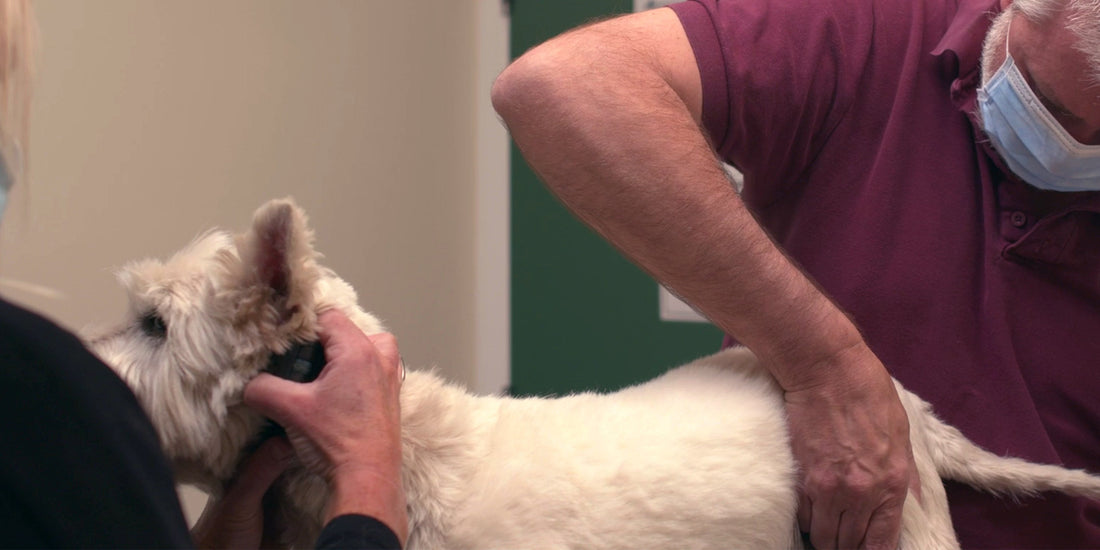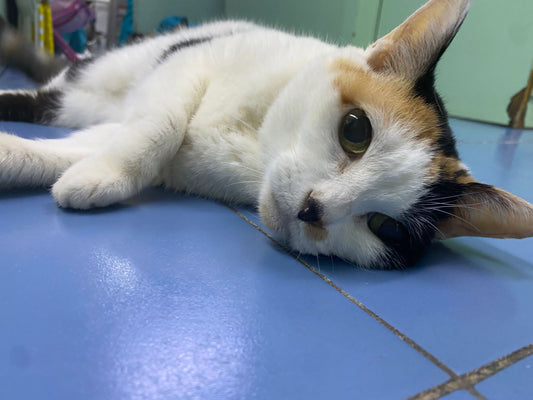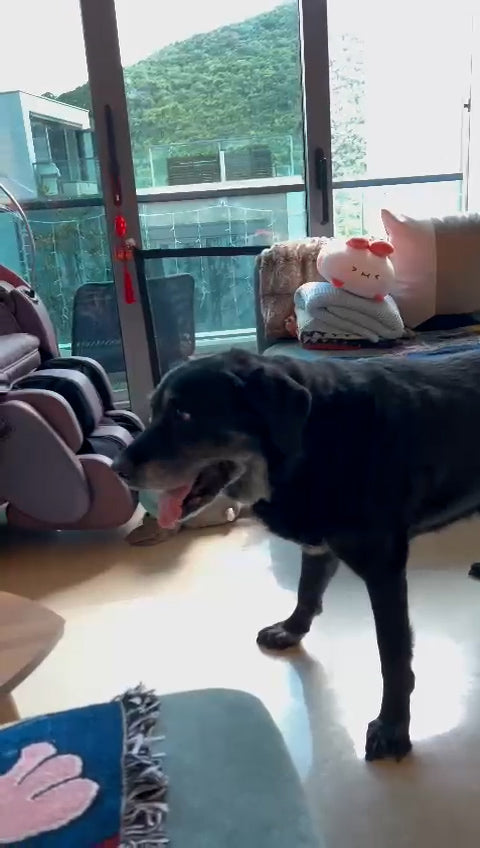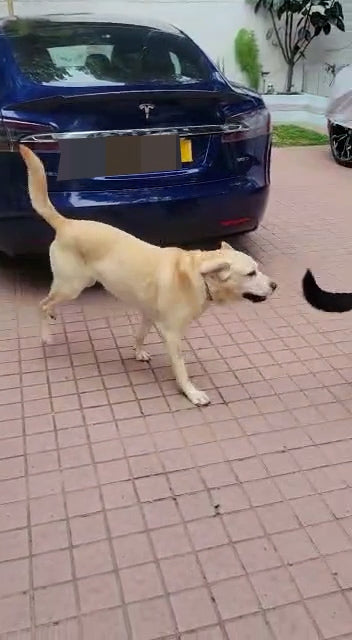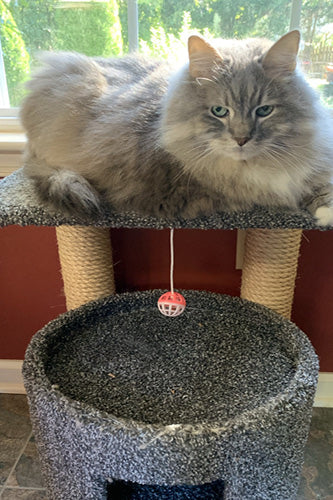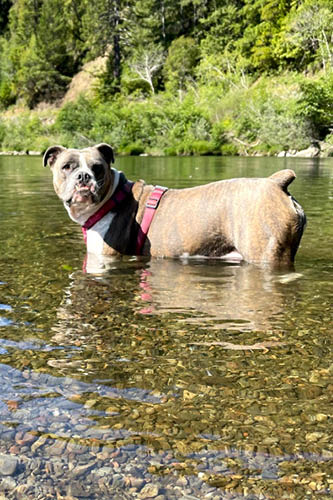Rupture of the cranial cruciate ligament (CCL) is the number one cause of lameness in the dog. In most joints of the dog and cat, the bones provide the majority of the stability. In the stifle joint however, the bones do not provide much stability. In fact, the CCL is the most important contributor to stability of the stifle joint (Figure 1). The CCL has three primary functions: (i) it prevents forward movement of the tibia on the femur, (ii) it limits internal rotation of the tibia, and (iii) it prevents the stifle joint from hyperextending (Figure 2). Given its importance in stabilizing the stifle joint, rupture of the CCL leads to the development of significant joint instability (Figure 1B). It is this instability that leads to pronounced acute lameness in dogs and cats with CCL rupture. This instability also results in abnormal cartilage wear in the joint and results in the progression of significant osteoarthritis (OA) in the stifle joint.
Biomechanics of the CCL:
High precision studies assessing stifle joint movement in dogs have shown that cranial cruciate ligament rupture (CCL-R) results in significant disturbances to the normal motion between the bones (femur and tibia) of the stifle joint.1 Recent mechanical studies have also shown that this abnormal motion associated with CCL-R, reduces the contact area between the femur and tibia thereby causing an increase in contact pressure within the joint. This increased instability in the stifle joint, coupled with increased joint pressures likely accounts for the initiation and progression of osteoarthritis that we see in dogs and cats with CCL-R (Figure 3).
Management of CCL-R Patients:
Over the past 5 decades, numerous surgeries have been described to address CCL-R. Despite this, no agreement on the best surgical choice has been achieved, and no one procedure has proved effective in restoring normal joint movement and uniformly preventing the development or progression of OA. This lack of consensus on the most appropriate treatment protocol suggests that we have not yet gained a full understanding of this complex disease process and which surgical interventions will provide the best clinical outcome.
Dogs with CCL rupture can be managed conservatively or with surgery. Conservative management tends to produce the best results in dogs weighing less than 15 kg. Regardless of their size however, most dogs benefit from surgical management of CCL-R. The goal of surgical intervention is to restore some stability to the joint, thereby preventing ongoing wear and loss of cartilage. Surgical restoration of joint stability typically results in a significant reduction in lameness with improved patient comfort and limb function. Sadly however, regardless of the surgical technique performed, the development and progression of OA is inevitable. Therefore, irrespective of what (if any) surgery is performed, it is imperative that dogs and cats with CCL-R are managed appropriately to help treat and mitigate the inevitable progression of OA.
Management of the Dog/Cat with Stifle Osteoarthritis:
Osteoarthritis, which is also referred to as degenerative joint disease (DJD), is the most common joint problem encountered in people and animals. Osteoarthritis can be very debilitating to a patient and left untreated can result in an unacceptable quality of life for the pet. Appropriate management of OA requires a multifaceted approach (Figure 4). All too often pets (and even people) with OA are treated solely with a joint supplement that contains glucosamine, chondroitin and/or other cartilage analogues. This management approach vastly underestimates the complexity of OA and is typically met with suboptimal results. Note that we do not talk about OA “treatment”. The word treatment suggests that OA can be cured. Sadly, no “cure” exists for OA in people or animals. When present, it is therefore vital that OA is managed from early in the course of the condition, with appropriate management continued life-long.
Weight Management
Being at an appropriate body condition is the single most important component of the management protocol for pets with OA. In a recent report that assessed almost 2 million dogs presenting to veterinary clinics in North America, 51% of presenting dogs were classified as overweight.2 Shockingly, less than 10% of these overweight cases were successful at losing weight. Furthermore, 40% of dogs that did lose weight ended up regaining the weight within 12 months. In a more recent report assessing more than 4 million dogs and almost 1 million cats, the prevalence of overweight animals was significantly higher in those diagnosed with OA compared to animals without OA.3 Interestingly, a recent survey found that 33% of pet owners reported weight gain in their pet as a result of spending more time with their pet secondary to COVIDrestrictions. 3 Clearly, obesity is a huge problem in our pets, it is associated with OA, and recent global events have only worsened the problem. Weight loss can be incredibly challenging and partnering with a veterinarian or even with a board-certified veterinary nutritionist may help considerably in achieving weight loss at a healthy rate. When considering weight loss, the formula can be made very simple – feed fewer calories and exercise more. Of course, when OA is at play, especially in advanced cases, exercising can be challenging.
Some simple tips that can really help:
- Talk to your veterinarian to determine the appropriate weight for your pet
- Have your veterinarian calculate the appropriate daily calorie intake to achieve the desired weight loss safely
- Try using a weight-loss diet. This can help your pet eat the same quantity as before and feel full/satisfied, all while consuming fewer calories
- Weigh your pet once a week and write it down – otherwise you won’t know if you are being successful
- Slowly re-introduce more exercise and as your pet loses weight
- Cut out the commercially available pet treats- they are typically very calorie dense
- Good low-calorie treat alternatives include:
- Baby carrots ~ 4 calories
- Spinach (1 cup) ~ 7 calories
- Watermelon ball ~ 4 calories
- Pumpkin (1/4 cup) ~ 7 calories
- Ice – 0 calories
Exercise Modification
Notice that this section is not titled “exercise restriction”! A common misconception amongst owners and even with some veterinarians, is that dogs with OA should be activity restricted, as this leads to less pain and discomfort. Dogs that have OA are already in a state of cartilage loss. As owners and/or veterinarians we need to do everything we can to protect remaining cartilage and, if possible, permit some cartilage repair. Restricting a pet’s activity because of OA is like a death sentence for the cartilage cells that are already compromised. This is because activity results in joint range of motion. This motion circulates the joint fluid within the joint, bringing nutrients to the chondrocytes (cells of cartilage) and removing the byproducts of chondrocyte metabolism. Cartilage does not have a very robust blood-supply and instead relies on joint fluid for most of its nutrition and metabolic needs.
While we do not typically recommend activity restriction, if the pet is very painful or has an acute flare up of OA pain, it can be helpful to limit activity to leash walks outside for urination and defecation for a period of 7-10 days. Long term, however, joints require activity for proper health and so maintaining a consistent level of activity is key. In general, no activity needs to be prohibited, however, pets are typically more comfortable with low impact activity rather than high impact activities. Activities that are good for the joint include swimming, walking, walking in water (e.g. an underwater treadmill or walking in water at the beach, lake or river-edge). High impact activity (such as running, jumping, playing etc.) causes more concussive trauma to the joints and tends to cause more discomfort.
As a pet owner you have to balance allowing your pet to enjoy life as much as possible with controlling their activity to prevent them overdoingit and causing a flare-up. You will learn what your pet can and cannot do. It is important to remember that every time there is a flare-up and an associated increase in lameness, there is more inflammation ongoing in the joint which is detrimental to the remaining cartilage. Therefore, one should try to avoid these events as much as possible. Regardless of the activities performed, of more importance is that activity is provided on a regular (ideally daily) basis. As mentioned already, joint health requires joint movement. If the pet is activity restricted all week long (e.g. when owner is at work) and then the pet goes to the park for an hour on the weekend, a flare-up of joint pain is predictable. This is obviously not good for joint or cartilage health.
Physical Therapy:
Formal physical therapy can play an important role in regaining lost muscle mass and strengthening muscle mass. In many cases, strengthening muscle mass to help in joint stability, improving core strength and working on range of motion can significantly improve the quality of life for the pet. It is worth discussing this with your veterinarian or veterinary physical therapy specialist. Often times they can show you a plethora of strengthening and conditioning activities that can then be performed at home.
Pain Management
In order for patients to be comfortable enough to be active, their pain must be adequately managed. The long-term goal in treating osteoarthritis is always to have patients on the least amount of medication possible. Working on weight loss and improving strength with low impact activities often will enable us to decrease the dose, or frequency of giving oral pain relievers. However, with flare ups, high impact activity, or when OA is first diagnosed, treating consistently with a pain reliever for a period of 1-2 weeks can be very helpful.
If the pet can tolerate it (no systemic illness, no liver or kidney issues), a non-steroidal anti-inflammatory drug (NSAID) is often the first choice for OA pain management. When NSAIDs are used long term, screening bloodwork should be performed by your veterinarian every 4- 6 months to determine if any side effects are occurring, or if new systemic disease is developing that may preclude the continued use of an NSAID. In general, cats should not be on an NSAID long term, given the concern for kidney disease.
While NSAIDs are often the first-line defense for pain control in pets with OA, there are many other pain medications that have a better safety profile, that can be also be given (either with NSAIDs or alone). Two of the most common medications used are Gabapentin and Amantadine. It should be noted that some of joint supplements (see below) can also be helpful in controlling pain. Your veterinarian can help determine an appropriate pain control protocol for your pet, recognizing that what works for one pet may not be as efficacious in another.
Joint injections can also be performed to help with signs of OA. Injections with corticosteroids, hyaluronic acid and various biologics such as platelet rich plasma (PRP), and stem cells can all be considered. What should be injected is based upon the individual patient’s needs and should be discussed with your veterinarian.
Supplements:
There is a plethora of different joint supplements available for both people and pets. It is easy to get overwhelmed when deciding what, if any, supplements your pet should be on. Sadly, for many supplements, marketing has gotten ahead of the science and appropriate studies have been performed to assess their efficacy. In the USA there are no FDA regulations on supplements and therefore manufacturers do not have to meet the label claim- i.e. oftentimes the supplement does not contain the ingredients listed on the label.
For me, in order to prescribe and promote the use of any medication or supplement, that product should be backed up by appropriate scientific research. In my personal opinion, many supplements are overpriced and do not offer a good return on investment. Most joint supplements contain the building blocks of cartilage for example chondroitin and glucosamine. The theory behind their use is that when taken orally, these substances will be absorbed, transported to the joint and converted into new cartilage where cartilage loss has occurred. The evidence supporting that this actually happens however, in people or in pets, is scant at best. For this reason, I do not regularly prescribe these types of supplements.
Another type of joint supplement is one that aims to protect the cartilage that remains in the joint (as opposed to purporting to help build new cartilage). Intuitively, this treatment approach makes much more sense to me. The primary supplement category that works in this way is marine based oils. Arthritis literally means inflammation (“itis”) of the joint (“arth”). Marine based oils are rich in Omega-3 fatty acids which are natural anti-inflammatories and thus when used regularly can reduce inflammation in the joint and thereby even reduce pain levels. Their use can also result in reductions in the dose or frequency with which we need to administer NSAIDs. Furthermore, marine based oils are very safe with minimal to almost no side effects. Personally, I have been using Antinol for a number of years now and this is my marine oil supplement of choice. Antinol is a patented supplement from the New Zealand green-lipped mussel. It is rich in Omega-3 and other essential fatty acids. I have seen profound improvements in many patients with OA after starting Antinol. Antinol is also backed up by university-based research that has proven its efficacy in patients with OA; in fact, 90% of dogs with OA improved within 4 weeks of starting Antinol!
Figures:

Figure 1: Lateral tibial X-ray of a dog with a normal stifle joint (A) and a dog with a CCL-R (B). Note that the tibia (yellow Asterix) has a slope at the level of the stifle joint (white dotted line). As a result, the femur (white Asterix) wants to slide down this slope (red arrow). Clearly the bones are not providing much stability in the stifle joint. In figure B, the CCL has ruptured resulting in the femur sliding down the tibial slope. Notice how the center of the femur and tibia (green dots) are very close together in A but are separated in B because of the instability introduced following CCL-R.

Figure 2: Lateral X-ray of a right tibia. The cranial cruciate ligament (CCL) is a large ligament made up of collagen fibers (represented by the white lines here) and travels from the femur to the tibia. The primary job of the CCL is to prevent the tibia from moving forward (red arrow) and the femur from moving backwards (green arrow) during weight-bearing.

Figure 3: Lateral tibial X-ray showing a normal stifle (A) and a stifle with OA secondary to CCL-R (B). Notice the cloudy color in the front and back of the joint (white arrows). This is increased fluid in the joint that occurs when the CCL ruptures and is known as “joint effusion”. Notice also how the bones around the joint in B are very irregular/jagged (yellow arrows). These are osteophytes (AKA “bone spurs”) which are characteristic changes that are seen with OA.

Figure 4: Management of osteoarthritis (OA) requires a multi-faceted approach to yield optimal outcomes.
References:
- Tinga, S., Kim, S. E., Banks, S. A., Jones, S. C., Park, B. H., Pozzi, A., & Lewis, D. D. (2018). Femorotibial kinematics in dogs with cranial cruciate ligament insufficiency: a three-dimensional in-vivo fluoroscopic analysis during walking. 1–9.
- Veterinary Emerging Topics (VET) Report. (2020). Overweight pets: let’s talk before the problem gets any bigger. 1-28. 3. Veterinary Emerging Topics (VET) Report. (2021). Shining a light on a heavy risk: Help pet owners identify and reduce OA in pets. 1-22.
